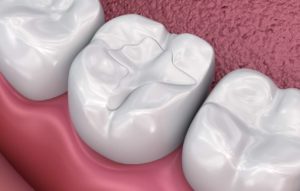 At one time (not that long ago), dentists almost always pulled teeth that had cavities or other problems. Fortunately, modern dentists focus on prevention and restoration and only recommend extractions as a last resort. One of the main procedures used to repair a damaged tooth is a dental filling. Nearly everyone has gotten one at some point, but it’s still quite common for patients to be unsure of how fillings work. Another common question is, “Do they ever need to be replaced?” Keep reading to find out how fillings improve your oral health and how to tell when they need to be replaced.
At one time (not that long ago), dentists almost always pulled teeth that had cavities or other problems. Fortunately, modern dentists focus on prevention and restoration and only recommend extractions as a last resort. One of the main procedures used to repair a damaged tooth is a dental filling. Nearly everyone has gotten one at some point, but it’s still quite common for patients to be unsure of how fillings work. Another common question is, “Do they ever need to be replaced?” Keep reading to find out how fillings improve your oral health and how to tell when they need to be replaced.
How Do Dental Fillings Work?
Fillings are a type of dental restoration that repairs chips, cavities, and small fractures. After a dentist removes damaged tooth structure, they put filling material in its place to restore the function and appearance of a tooth.
Up until several decades ago, the types of materials available were limited. Today, a wider variety of materials can be used, including tooth-colored composite, which has allowed fillings to look and function better than ever. In addition to blending in with the rest of your smile, composite material bonds to the surrounding tooth structure, helping it seal out cavity-causing bacteria. Unfortunately, however, even composite dental fillings need to be replaced at some point due to daily wear-and-tear.
When Do Dental Fillings Need To Be Replaced?
The lifespan of dental fillings can vary quite a bit, but the average is about 10-15 years. In that time, a filling typically starts to get worn down or develops chips or cracks. This creates a small gap between the filling and your tooth, giving cavity-causing bacteria an entry point into your tooth.
In many cases, patients don’t feel this process occurring, especially in the early stages. That’s why it’s important to see a dentist in Salem for regular checkups to have your fillings and other dental work closely monitored. During your exam, they’ll use a special instrument called an explorer to detect problems around the edges of your fillings and also take routine X-rays (usually once per year) to see if there’s tooth decay underneath your fillings.
By catching problems right from the start, a dentist can replace your dental work before a cavity develops and damages more of your tooth structure. Ultimately, that helps you avoid toothaches and more extensive dental work, which everyone can agree is a good thing!
About the Author
Dr. Travis Cochell is a general, cosmetic, and restorative dentist in Salem with over a decade of experience. He provides outstanding restorative care and always encourages his patients to schedule regular checkups to catch problems with their existing dental work early on. If you have any other questions about dental fillings, he can be reached via his website.
